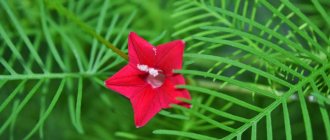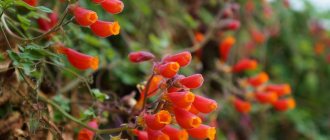Features of dolichos
Under natural conditions, dolichos can be found in East Africa. In regions with mild and warm winters, this flower is grown as a perennial, but in areas with harsher climates it is grown as an annual plant. Flowering occurs in mid-July. Long racemose inflorescences consist of very small white or purple flowers. The flowers have a pleasant aroma, somewhat similar to the smell of lilac. Quite often, this plant is cultivated as an ornamental crop, and it is perfect for decorating fences, gazebos and decorative arches.
This climbing vine has large leaf plates of rich green color, against which pink or pale purple inflorescences and purple pods look very impressive. The height of such a vine is about 600 centimeters, which allows it to be combined with other climbing plants. Therefore, it is often used for vertical gardening, creating spectacular compositions. The fruits of this plant have healing properties and are also eaten. A large number of delicious dishes are prepared from dolichos beans.
Varieties
Three varieties of hyacinth beans are popular, which are not demanding to care for and have excellent decorative qualities.
Ruby Moon
The stem length is 4-4.5 m. The leaf blades are dark green with red-violet veins. Flowering is abundant from early July to mid-October, less often until the end of October. The length of the inflorescences reaches 45 cm. The flowers are bright pink and have a weak aroma. The beans are dark purple and decorate the plant until the first hard frost.
Lilac cascade
The stem length is 4-5 m. It branches well, which provides a lush appearance to the bush throughout its development. The foliage is dark green. Flowering from late June to early October. The flowers are dark lilac. Resistant to cold weather. Ideal for cultivation on balconies.
Purple garland
Stem length – up to 5-6 m. Large leaves with purple veins. The long brushes look like garlands, which is why the variety got its name. Flowers and beans are deep purple.
Hyacinth beans are often used as green manure. True, it will be difficult for an ordinary flower grower or gardener to decide to cut a flowering plant in order to bury it in the garden bed. It is at this stage that the benefits of green manure-lobia during decomposition in the soil will be high. But even in late autumn after the onset of frost, do not throw away the remaining parts of the lobia. Try burying them in your garden beds - this will provide additional organic matter for the plants by next spring.
Planting and caring for dolichos in open ground
In mid-latitudes, dolichos are usually grown through seedlings. The seeds of such a plant, collected with your own hands, remain viable for 5 years. You can also sow seeds directly into open ground; this is done in May. However, in this case, the bush will grow for a very long time, and the first flowers can be seen no earlier than the end of August. Because of this, experienced gardeners recommend growing dolichos through seedlings.
Growing seedlings
Sowing of seeds is carried out at the end of February. Seed material needs pre-sowing preparation. To do this, place it on moistened gauze and put it in a warm place. But before soaking the seeds, the shell of each bean must be carefully pierced with a sharp needle, but do not touch the white spot on the edge, because this is where the germinal zone is located (the sprout emerges from it).
To begin, fill small cups with a substrate consisting of sand, leaf turf and peat. One seed is sown in each container, and it must be embedded in the soil mixture to a depth of about 40 mm. The crops are carefully moistened with a spray bottle, covered with film on top and transferred to a warm place with diffused light. In order for seedlings to appear as quickly as possible, do not forget to regularly ventilate and moisten the crops with a spray bottle, and also make sure that they are warm (about 23 degrees).
Dolichos, ornamental bean, planting seedlings
Planting seedlings in the ground
When the seedlings grow up and become stronger, they are transplanted into the garden. Planting is carried out in May after warm weather sets in, when the threat of spring frosts is behind us. In order for the seedlings to take root as quickly and well as possible, they are carefully transferred from the cups into the prepared hole, while trying to keep the lump of earth intact. The distance between planting holes can vary from 0.2 to 0.4 meters. Near the planting, immediately place a support, which should be at least 200 cm in height. For planting, choose a sunny area, because this plant is light- and heat-loving. The place chosen for planting dolichos must also be reliably protected from strong winds and drafts, because they can greatly harm it and even cause the death of the bushes.
The soil on the site should be loose, nutritious and neutral. Before planting seedlings, do not forget to dig up the area. If the soil is depleted, then about 30 days before planting the seedlings, rotted compost is added to it.
Watering
This plant needs systematic watering. Make sure that the soil surface is constantly moist, but do not allow liquid to stagnate in the roots, otherwise rot may appear on the root system. Systematically pour a small amount of water under each plant once every three days. In the hot dry season, the frequency of watering is increased to 1 time every 2 days. Do not forget to loosen the surface of the soil mixture after each watering and remove weeds.
Suitable soil
For the plant, it is recommended to choose areas with loose nutrient soil of a neutral reaction. It should allow water and air to pass through well, and also contain a minimum amount of nitrogen. Before planting the seedlings, the soil on the site is dug up, and rotted organic fertilizer, as well as peat or sand, are added to it. If the soil on the site is acidic, then during digging, a little lime or charcoal is also added to it.
March 27, 2021 Amazing plant, climbing lilac, Dolichos or hyacinth bean..
Transfer
Dolichos are replanted only once, when it is planted from a seedling container into open ground. Transplantation is carried out by transshipment; to do this, carefully remove the plant along with a lump of earth from the cup and carefully place it in the hole. Seedlings planted in the soil must be watered, and it is recommended to cover the surface of the soil around them with a layer of mulch so that the moisture evaporates more slowly. For this you can use dry peat.
Top dressing
Dolichos must be regularly fed once a month with complex mineral fertilizer. If the vine has enough nutrients, it will remain spectacular and attractive until frost.
Bloom
Bushes grown through seedlings begin to bloom in June. Long fragrant racemes of yellow, lilac, white or pink appear on them. The lifespan of one inflorescence is approximately 3 weeks, which is why, with good care, bushes can bloom for a very long time (until frost). When the inflorescence fades, dark purple-colored fruits are formed on it, represented by pods; they are also highly decorative, like the flowers themselves. The fruits grow in bunches, with 2–4 beans inside. Each seed has a white spot on its rib. They are edible and are widely used in preparing a variety of dishes.
Trimming
Dolichos does not need to be pruned. The only thing is that before the side branches grow, you need to regularly pinch the tops of the stems. And don’t forget to install a support next to the planting, along which the bush can freely climb up.
Wintering
In mid-latitudes, dolichos is cultivated as an annual plant, so there is no need to prepare it for wintering. After the bushes begin to wilt, they are simply removed from the site and destroyed.
Climbing plants for hedges! Dolichos for a summer hedge!
Dolichos growing from seeds
Dolichos can be propagated by seed and seedlings. When planting beans in open ground, the plants take a very long time to germinate and bloom only at the end of summer.
It is for this reason that gardeners do not use this technique, but prefer to propagate Egyptian beans using seedlings. For this purpose, take the beans, damage the skin on them, avoiding the sprout zone, and soak them for a day, placing them on damp gauze in a warm place. Then the seeds are planted in peat peas, one at a time, to a depth of 4 centimeters. After this, they are covered with film, moistened and put away in a warm place with diffused light.
To obtain quick shoots, seedlings are ventilated daily, systematically moistened and maintained at a temperature of 20 to 23 degrees.
They are transferred to open ground by transferring the excavator into pre-prepared holes. Seedlings are planted in mid-May.
The bean plant or laburnum is also a member of the Legume family. It can be grown when planted and cared for in open ground without much hassle, if you follow the rules of agricultural technology. You can find all the necessary recommendations in this article.
Reproduction methods
As mentioned above, dolichos in mid-latitudes is grown from seeds, and it can be propagated either by seedlings or without seedlings. If you decide to sow seeds directly in open ground, then you should take into account that the bushes will grow for a very long time and will begin to bloom only in the last weeks of summer. That is why gardeners prefer to grow such a flower through seedlings, and how to do this is described in great detail above in the “Growing Seedlings” section.
Disease and pests
A plant such as dolichos is highly resistant to diseases. However, it may suffer due to improper care, for example, the leaves of the bush may turn yellow or it may not bloom. In order for the vines to become green again and bloom luxuriantly, they need to be fed. Also, in the future they should be provided with regular feeding. Remember that this flower reacts extremely negatively to nutritional deficiencies.
Pests also try to avoid this vine. However, aphids or caterpillars can still harm it. If you notice them on the bushes, then spray the foliage with a solution of the insecticidal drug Actellica as soon as possible, and do not forget to follow the instructions that you can find on the package.
Types and varieties of dolichos with photos
Dolichos Lablab
This species is native to Western Europe. In Russia it is cultivated as an annual. The height of such a climbing plant is about 500 cm. Strongly branching stems are decorated with green and purple leaves. During flowering, brushes are formed on the bush, which contain 40 small flowers. The length of the racemose inflorescences can reach half a meter; in appearance they look like garlands. The color of the flowers can be pink, white or cream. They don't smell of anything. Flowering begins in the middle of summer and ends with the first frost.
Dolichos vulgaris
The length of such a vine can reach up to 450 cm. The leaves can be colored green or purple. The homeland of this species is considered to be Western Europe, where it is cultivated as an ornamental perennial. Flowering occurs in mid-summer. At this time, long, large inflorescences are formed on the bushes, consisting of many pink, white or cream flowers. When flowering ends, pods of a dark purple hue are formed in place of the flowers, inside of which there are seeds (edible beans).
Dolichos Ruby Moon
The flexible stems of this vine reach a length of about 400 cm. The heart-shaped leaves in the upper part are pointed, they are colored rich green with a purple tint. The long racemes consist of large lilac flowers. Flowers of this type can be used for cutting; they stand in water for a long time and smell very pleasant. The species blooms in mid-June. Upon completion of flowering, dark purple pods form on the bush, which do not fall until the second half of autumn and are an excellent decoration for dolichos.
Dolichos Purple
This herbaceous ornamental vine is cultivated as an annual. The length of the shoots is about 300 cm, they are decorated with large heart-shaped leaf plates with a pointed tip. The leaves are green with a purple-red tint. Fragrant long brushes consist of flowers of pink, purple, white or crimson color. Flowering is observed in the middle of the summer period, and after its end, pods with edible beans appear on the bush.
Dolichos Hyacinth
The length of the stems of this herbaceous decorative vine is about 400 cm. Large heart-shaped leaves have a pointed tip, they are colored green with a purple tint. The composition of the long fragrant brushes includes lilac flowers. This vine blooms in mid-summer. In place of faded inflorescences, dark purple pods appear, inside of which there are edible seeds.
Dolichos Pink Moon
This species is considered the most decorative of all known dolichos species. The length of its stems is about 400 cm. The large heart-shaped leaf plates have a point at the top, and they are painted in a rich green shade. Purple long brushes have a pleasant scent. When flowering ends, dark purple pods are formed containing beans.
Dolichos Purple Garland
The length of the stems of such a vigorous vine can reach about 600 cm. The dark green large leaves are heart-shaped. During flowering, purple clusters are formed that look like spectacular garlands. Upon completion of flowering, the bush retains its decorative properties due to the formation of dark purple pods in which the seeds ripen.
Dolichos Lilac Cascade
Unlike other species, this plant's branched stems are more compact. One vine can grow up to 30 shoots. The large, heart-shaped foliage is dark green and has a pointed tip. This species does not bloom very profusely (if you compare it with other species), but its long brushes, painted purple, look very impressive. When flowering ends, the bush is decorated with dark purple shiny pods formed in place of the flowers, inside of which there are seeds (beans).
Hyacinth beans: plant description
Hyacinth beans: photo
This plant grows up to 5 m in length and forms a large number of stems. The leaves of hyacinth beans are collected in 3 pieces in one petiole. The color of the leaves is green with bright, very prominent purple veins on the back of the leaf. Flowers form on top of the shoots, and then beans, which are arcs - stripes of pink color.
Each fruit produces approximately 5 seeds. The seeds of hyacinth beans are the same as those of other beans and have a dark shade. There are also white seeds, their size is quite large. The hyacinth bean is native to East Africa. Russian summer residents grow these beans as annuals.
Flowering period
Hyacinth beans bloom around the beginning of summer, and to be more precise, it will be the second half of June. The flowering period lasts until late autumn.
The flowers are collected in inflorescences that form a raceme. Each of them blooms for about 30 days. Reaching their climax, the flowers bloom and then begin to fall. The color of the petals usually has pink tones. These can be both light and dark colors, closer to a purple hue. Sometimes white inflorescences are also found. The flowers have a pleasant and unobtrusive aroma.
Dolichos in cooking: recipes
As mentioned above, the fruits, or rather the beans, of dolichos can be eaten. They look and taste similar to beans. However, dolichos is much more tender than beans and has a more pleasant taste. Dolichos seeds contain a large amount of starch and vegetable protein. That is why such beans are very filling and help restore strength in a short time. A wide variety of dishes are prepared from young pods as well as mature beans.
The beans of this plant go well with rice, stewed vegetables, seafood and poultry. They can also be added to soup or salad. Below are several recipes that will help you learn how to cook delicious dishes with dolichos.
Soup with dolichos and coke cream
A savory and hearty soup made from spices, dolichos and coconut cream. This dish is perfect for both a family dinner and a small celebration. To prepare it you need to prepare:
- two chicken backs;
- one medium-sized onion;
- 0.45 kg of dolichos beans;
- 0.2 liters of coconut cream;
- six tablespoons of lime juice;
- four bay leaves;
- half a teaspoon each of dried garlic, cumin and turmeric;
- four chili peppers;
- one tablespoon of dried tomatoes and the same amount of dried ginger.
In order to prepare the soup, first you need to take a saucepan and pour 3 liters of clean water into it, and then put peeled and chopped onions, chicken backs, and bay leaves into it. You need to prepare broth from these products. Remove the bay leaf, chicken, and onion from the finished broth. Carefully remove all bones from the meat. Strain the broth until it is clear. Fill the dolichos beans with warm water in advance so that they have time to stand for four hours. Add cream to the finished broth and mix everything well. After this, seasonings, finely chopped chili peppers, spices, prepared beans and chicken are poured into it. Place the pan on the fire and let the soup boil, then reduce the heat and cook the dish until fully cooked. When the soup is half ready, add salt to it. Place the finished dish on plates and garnish with finely chopped fresh herbs on top. It is also recommended to add a small amount of lime juice to each plate.
Unusual pasta with dolichos
Pasta served with herbs, dolichos and cheese is a very unusual and tasty dish, notable for its satiety. You only need about 1 hour to prepare it.
First of all, prepare all the necessary products:
- one and a half glasses of pre-boiled dolichos;
- 0.23 kg small spiral pasta;
- half a teaspoon of lemon zest;
- 0.15 kg Parmesan cheese, grated;
- a quarter cup of olive oil;
- a full glass of chopped parsley;
- one bunch of fresh green onions;
- pepper and salt are added to taste.
To prepare this delicious dish, start by boiling the pasta in salted water until cooked through. When there are a few minutes left until it is ready, add dolichos into the pan. Place the contents of the pan in a colander and wait until all the liquid has drained. Place the prepared beans and pasta in a deep bowl, and also add chopped onion and parsley, as well as pepper, lemon zest, cheese and olive oil. Mix everything well and the dish will be ready. All that remains is to arrange it on plates and serve it to the table.
Chicken with carrots and dolichos
Chicken fried with vegetables and incredibly tasty ginger-soy sauce has a very unusual spicy taste and looks appetizing. Despite the name, there is nothing difficult in preparing this dish. The first thing you need to do is prepare all the necessary products:
- 0.45 kg chopped chicken fillet;
- a full glass of dolichos beans, which need to be boiled until half cooked;
- a couple of tablespoons of soy sauce and cornstarch;
- a quarter glass of orange juice;
- one and a half glasses of ready-made chicken broth;
- half a teaspoon of dried red pepper;
- one tablespoon of sesame seeds, which need to be fried, and the same amount of grated ginger;
- three glasses of pre-boiled quinoa;
- a couple of tablespoons of water;
- 0.45 kg grated carrots;
- one bell pepper, diced;
- three tablespoons of olive oil;
- three finely chopped garlic cloves.
To prepare this delicious dish, first take a deep and fairly spacious frying pan and put it on the fire. Then one tablespoon of olive oil is poured into it. When the oil is hot enough, add the prepared carrots to the pan. It is simmered, stirring regularly, for five minutes. After this, you need to add sweet pepper to the carrots. Continue simmering the vegetables for another three minutes. Place the contents of the pan into a cup. Pour one tablespoon of oil into the empty pan again. Once the oil is hot, add the prepared chicken to the pan. It should be fried for five minutes, remembering to stir regularly. Pour the finished chicken into a cup with vegetables, add dolichos there and mix everything thoroughly. Pour one tablespoon of oil back into the empty pan. When it is hot, add ginger, garlic and red pepper. The contents of the pan are fried for literally one minute. Then broth, soy sauce and orange juice are poured into it. Let the mixture boil. Pour starch into a glass and add cold water to it, mix everything well. Pour the starch into the pan while stirring constantly and boil the mixture for two minutes. Place dolichos with meat and vegetables in a frying pan and simmer its contents for ten minutes. The finished dish is served along with ready-made quinoa grains, with sesame seeds sprinkled on top.
Appetizing snack with dolichos and avocado
A savory appetizer with dolichos, avocado, onions and spices turns out very tasty and appetizing. As a rule, it is served with croutons or chips. The first thing you need to do is prepare the products:
- 0.2 kg of chips;
- one avocado without peel, cut into small cubes;
- a quarter cup of chopped onion;
- a couple of tablespoons of basil pesto;
- 0.32 kg dolichos beans, pre-boiled;
- six toasts;
- one chopped tomato;
- three tablespoons of lime juice;
- pepper and salt are added to taste.
Start by blending the onion, avocado, dolichos, lime juice, pesto, pepper and salt until smooth. Transfer the resulting mixture into a container and put it in the refrigerator. Then place the finished pasta on a plate and garnish with chopped herbs and tomatoes. The dish is served with chips and croutons.
Dolichos with beef
Beef and dolichos can make an extremely unusual and tasty dish. First of all, prepare the products:
- three tablespoons each of vegetable oil and teriyaki sauce;
- 0.25 kg veal tenderloin, cut into strips;
- one glass of dolichos beans, which are boiled until fully cooked;
- a teaspoon of chopped garlic;
- one chili pepper and one bell pepper.
Place the beef in a frying pan heated with oil and fry it for five minutes. Place it in a cup. Pour the beans into an empty frying pan and add a little water, fry them for a couple of minutes. After that, add pepper and fry the food for another three minutes. Also add the sauce and chopped garlic, and after a couple of minutes, remove the pan from the heat. Beef is combined with vegetables, everything is mixed. The dish is ready!
Hyacinth beans: cultivation and care











